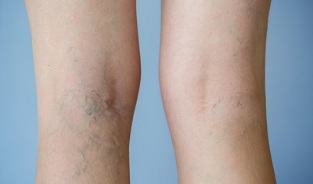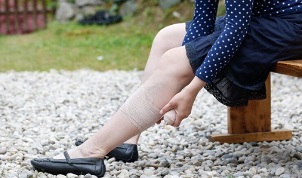
Signs of varicose veins in the legs are often found in women - this pathology is found in almost every third woman. This disease, accompanied by dilation of the lumen and thinning of the walls of the venous vessels, leads not only to the appearance of cosmetic defects, but is also accompanied by pain and malnutrition of the tissues of the lower extremities. As a result, if left untreated, a woman can develop trophic ulcers on her legs, leading to even more serious complications. That is why the beginning of the treatment of varicose veins should always be timely.
Signs of varicose veins in women are not always noticeable in the early stages - sometimes the disease lasts a long time.
Causes and early signs
The veins of the legs are affected by varicose veins under the influence of the following factors:
- overweight;
- heredity;
- sedentary lifestyle;
- long stay in static position;
- pregnancy;
- birth;
- taking high doses of contraceptives;
- increased abdominal pressure with frequent or prolonged coughing, sneezing or constipation;
- overload during physical training or exercise;
- leg injuries;
- pelvic pathology;
- excessive use of tanning or thermal procedures;
- with uncomfortable shoes;
- the habit of sitting cross-legged;
- alcohol abuse;
- old age.
Due to the increase in pressure in the venous vessels and the stagnation of the blood, the vessels dilate, the blood flows in them change the direction and speed of their flow, as the walls of the vessels change their tone and the valves stop functioning normally. As a result, changes in the veins lead to the development of a vicious circle in the hemodynamics and other functions of the venous vessels.
In the early stages of varicose veins, blood flow can still be compensated by conservative means - wearing compression underwear, gymnastics and the use of venotonic drugs. As the disease progresses, however, changes in the structure of the veins become irreversible and can only be removed surgically.
The symptoms of varicose veins can significantly disrupt the normal rhythm of life.
The following symptoms may be the first signs of varicose veins in the legs:

- weight in the legs;
- the appearance of telangiectasias - spider veins and webs of different colors (bluish, red, black);
- feeling of satiety during a long stay in a stationary position (sitting, standing);
- convulsions at night;
- relieve symptoms after walking or resting in a horizontal position.
Symptoms
Expansion of varicose veins in the later stages is manifested by the following symptoms:
- rapid fatigue in the legs;
- pain;
- feeling of fullness of fluid;
- swelling of soft tissues after exercise;
- translucency and bulge of large veins above the skin;
- itchy skin;
- bruising due to rupture of large vessels;
- skin peeling;
- hair loss;
- trophic ulcers.
Against the background of varicose veins in women in the lumen of the veins may form blood clots - blood clots. When they migrate through the bloodstream, consequences of varying severity develop: thrombosis, phlebothrombosis, development of cardiovascular disease, opening and suppuration of ulcers, penetration of blood clots into the vessels of the heart or lungs.
Diagnosis and treatment
To confirm the diagnosis, the woman should contact a vascular surgeon and undergo an examination. The diagnostic plan includes an examination with instrumental tests:
- Doppler ultrasound of the vessels of the legs;
- duplex angioscanning;
- rheovasography;
- X-ray and radionuclide methods.
The tactics of treatment of varicose veins of the legs are determined by the stage of the disease. Conservative means can be used early:
- wearing compression stockings or bandages;
- sufficient physical activity;
- wearing comfortable shoes;
- physiotherapy exercises;
- removal of static load on the legs;
- application of venotonics.
The duration of conservative therapy is individual and depends on the rate of disease progression and compliance with the doctor's recommendations. It can be supplemented with a special diet, which involves the introduction into the diet of foods that help strengthen the walls of blood vessels.
The likelihood of varicose veins giving way under the pressure of conservative treatment is determined by each clinical case. In many respects, the success of therapy depends on the timeliness of a visit to the doctor.
Also, these therapies are recommended at the stage of preparation for surgical treatment or for those patients who are contraindicated for invasive intervention.
Sometimes prevention of varicose vein progression may consist of minimally invasive interventions. They are only applicable to strict indications that are determined during the patient's examination.
Treatment of varicose veins in advanced stage usually involves surgery - minimally invasive or classic.

If possible, the woman is recommended radical treatment of varicose veins of the legs:
- compression sclerotherapy;
- laser coagulation;
- photocoagulation;
- radiofrequency coagulation.
If the impact of these minimally invasive techniques is not enough, then for more radical surgical treatment, classic operations are performed:
- miniphlebectomy;
- phlebectomy; Trendelenburg method (with complications of thrombosis and infection).
Sometimes classic surgical techniques are supplemented with the use of minimally invasive. This combination can reduce the trauma of operations and shorten the period of postoperative rehabilitation.
Varicose veins of the lower extremities can be successfully treated, especially in the early stages. That is why the first signs of this disease should always be a reason to visit a vascular surgeon. Varicose veins can appear at different ages and observations show that women are more likely to suffer from this disease. The signs of varicose veins in women are the same as in men.




































